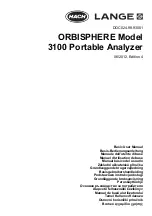
o.
Replace P2060 to the Normal mode position (one pin
to the right). The baseline will now be 180° or the inverse of
its previous position.
p. Deactivate and then activate VIEW A, VIEW B, SAVE
A, and MAX HOLD. Retrace and check new response. Re
sponse should appear flat (see Fig. 3-37B).
q. Switch POWER off, and reinstall the Video Processor
board. Disconnect and remove the signal to the RF INPUT
from the test equipment.
Calibration—492/492P Service Vol. 1 (SN B030000 & up)
Adjustment Procedure
r. Compensation adjustment R1065 is set at the factory
and usually does not require adjustment. Pull Leveler Dis
able plug P3035 then replace it. If the baseline remains
straight or breaks up after the plug is replaced, compensa
tion is required. Adjustment procedure is as follows:
1
) with the front-panel controls set as directed in part d,
activate NARROW Video Filter and change TIME/DIV to
50 ms. Alternately turn the 19 level adjustments
clockwise and counterclockwise so every other potenti
ometer is fully clockwise and the adjacent potentiometer
is fully counterclockwise. Display should now appear as
a periodic triangular waveform;
2) adjust the REF LEVEL so the baseline is near full
screen then switch to the 2 dB/DIV mode and adjust so
the display is mid-screen (see Fig. 3-38A);
> -
60
BNI
11
J738GHZ
m
A. Typical response before baseline leveling.
L
,
j
3008 5·4'18 _jUg.
B. Typical response after baseline leveling.
2 7 2 7 - 1 5 2
A. Series of waveforms. Am plitude approxim ately
±5 dB above and below baseline reference.
2 7 2 7 - 1 5 3
Fig. 3-37. Typical response displays when adjusting baseline
Fig. 3-38. Typical response displays when adjusting compen-
leveling.
satlon of baseline leveling circuits.
3-60
REV AUG 1981
















































